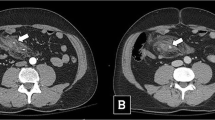Abstract
Purpose
Decision making in management of blunt bowel and mesenteric injury (BBMI) is difficult. This study aimed to identify indicators for laparotomy and appropriate time intervals to surgery.
Methods
We retrospectively reviewed our hospital’s trauma registry to identify patients with a diagnosis of BBMI from February 2011 to July 2017. Patients requiring therapeutic surgical treatment (OM group) were compared with those who did not (NOM group). Preoperative risk factors for surgery (with p < 0.1 by univariate analysis) were integrated in a multivariate logistic regression model. In the OM group, we identified relevant factors for time intervals to surgical interventions.
Results
Among 2808 trauma patients admitted to our hospital, 83 (3.0%) had bowel and mesenteric injury; 6 patients with penetrating trauma, 2 lethal, untreated cases, and 2 patients who underwent exploratory laparotomy were excluded. Finally, 73 patients (47 males), with a mean Injury Severity Score (ISS) of 23, were included. Results from univariate analysis identified three relevant factors between the OM and NOM groups: ISS score (p = 0.036), hemodynamic instability (p = 0.041), and free air (p = 0.0018). Multivariate analysis revealed one relevant factor, free air (p = 0.0002). Short intervals between hospital admission and intervention were associated with 7-day mortality (p = 0.029), hemodynamic instability (p = 0.0009), focused assessment with sonography for trauma positive (p < 0.0001), and mesenteric extravasation (p = 0.012).
Conclusions
Early surgical intervention is essential in cases of hemodynamically unstable BBMI and bowel perforation with free air; nevertheless, it is associated with high mortality. We suggest that prompt transport along with early intervention could significantly lessen mortality.

Similar content being viewed by others
References
Matsushima K, et al. Blunt hollow viscus and mesenteric injury: still underrecognized. World J Surg. 2013;37:759–65.
Watts DD, et al. Incidence of hollow viscus injury in blunt trauma: an analysis from 275,557 trauma admissions from the EAST multi-institutional trial. J Trauma. 2003;54:289–94.
McNutt MK, et al. Early surgical intervention for blunt bowel injury: the Bowel Injury Prediction Score (BIPS). J Trauma Acute Care Surg. 2015;78:105–11.
Bhagvan S, et al. Predicting hollow viscus injury in blunt abdominal trauma with computed tomography. World J Surg. 2013;37:123–6.
Hughes TM, et al. The pathophysiology and management of bowel and mesenteric injuries due to blunt trauma. Injury. 2002;33:295–302.
Richards JR, et al. Bowel and mesenteric injury: evaluation with emergency abdominal US. Radiology. 1999;211:399–403.
Bates DD, et al. Multidetector CT of surgically proven blunt bowel and mesenteric injury. Radiographics. 2017;37:613–25.
Menegaux F, et al. Diagnosis of bowel and mesenteric injuries in blunt abdominal trauma: a prospective study. Am J Emerg Med. 2006;24:19–24.
Chereau N, et al. CT scan and diagnostic peritoneal lavage: towards a better diagnosis in the area of nonoperative management of blunt abdominal trauma. Injury. 2016;47:2006–11.
Malinoski DJ, et al. A diagnostic delay of 5 hours increases the risk of death after blunt hollow viscus injury. J Trauma. 2010;69:84–7.
Fakhry SM, et al. Relatively short diagnostic delays (< 8 hours) produce morbidity and mortality in blunt small bowel injury: an analysis of time to operative intervention in 198 patients from a multicenter experience. J Trauma. 2000;48:408–14 (discussion 414–5).
Biswas S, et al. Abdominal injury patterns in patients with seatbelt signs requiring laparotomy. J Emerg Trauma Shock. 2014;7:295–300.
Valmahos GC, et al. The “seat belt mark” sign: a call for increased vigilance among physicians treating victims of motor vehicle accidents. Am Surg. 1999;65:181–5.
Wotherspoon S, et al. Abdominal injury and the seat-belt sign. Emerg Med (Fremantle). 2001;13:61–5.
Gelfi J, et al. Arterial embolization in the management of mesenteric bleeding secondary to blunt abdominal trauma. Cardiovasc Intervent Radiol. 2016;39:683–9.
Raharimanantsoa M, et al. Proposal of a new preliminary scoring tool for early identification of significant blunt bowel and mesenteric injuries in patients at risk after road traffic crashes. Eur J Trauma Emerg Surg. 2018;44:779–85.
Author information
Authors and Affiliations
Corresponding author
Ethics declarations
Conflict of interest
The authors have no conflicts of interest to declare.
Ethical approval
The study protocol has received approval from the Research Ethics Committee of Wakayama Medical University (approval number: 2548), and the requirement for study participants’ written informed consent was waived.
Rights and permissions
About this article
Cite this article
Okishio, Y., Ueda, K., Nasu, T. et al. Surgical intervention for blunt bowel and mesenteric injury: indications and time intervals. Eur J Trauma Emerg Surg 47, 1739–1744 (2021). https://doi.org/10.1007/s00068-019-01192-4
Received:
Accepted:
Published:
Issue Date:
DOI: https://doi.org/10.1007/s00068-019-01192-4




